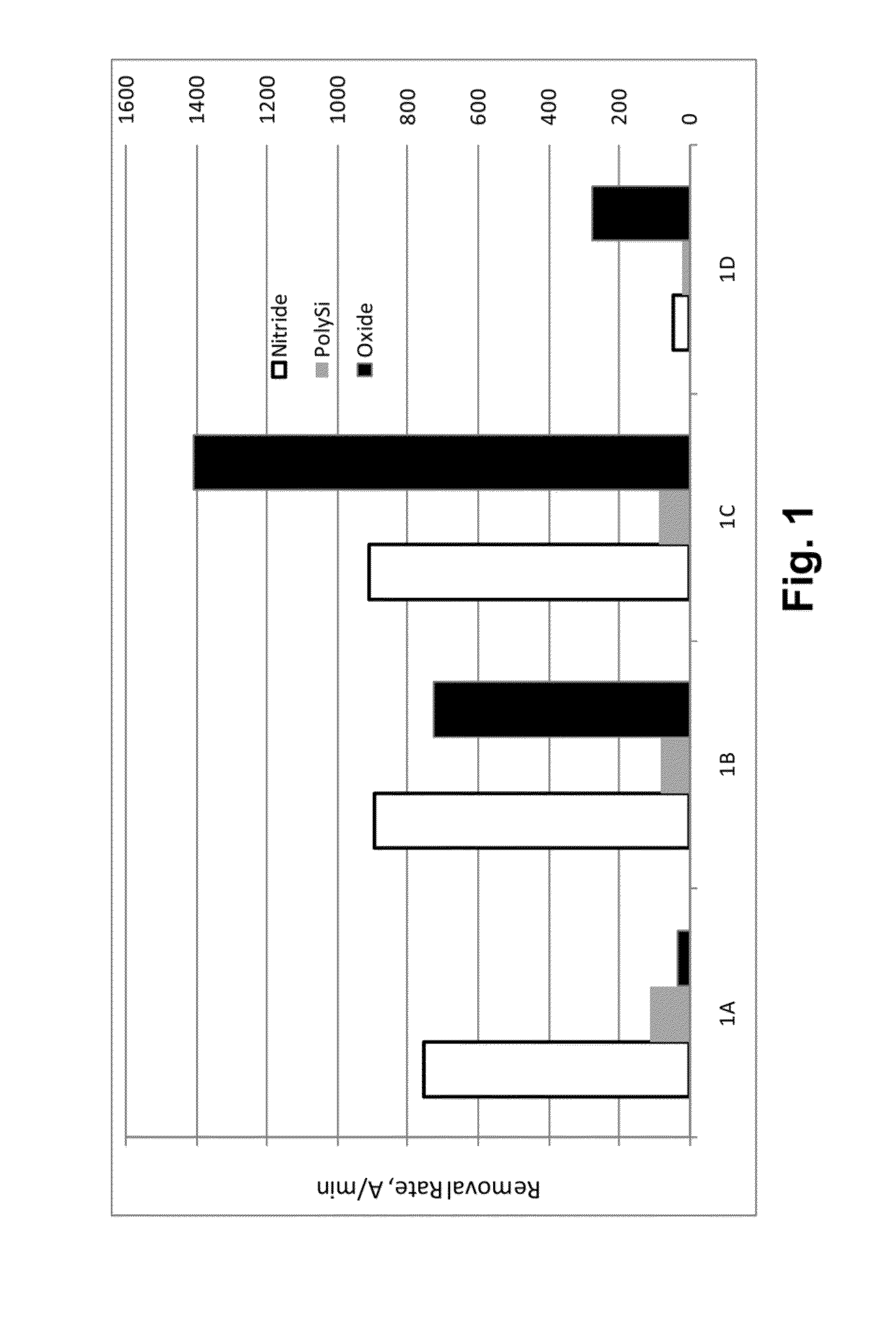Compositions and methods for selective polishing of silicon nitride materials
a technology of silicon nitride and composition, applied in the direction of electrical equipment, chemical equipment and processes, other chemical processes, etc., can solve the problems of poor manufacturing yield, unacceptable polishing rate, and inability to selectivity for the removal of insulator materials used in wafer manufacturing, and achieve low polysilicon removal rate and high silicon nitride removal rate
- Summary
- Abstract
- Description
- Claims
- Application Information
AI Technical Summary
Benefits of technology
Problems solved by technology
Method used
Image
Examples
example 1
[0043]This example illustrates the effect of cationic polymers and a non-polymeric UNH compound on removal of silicon nitride, polysilicon, and silicon oxide.
[0044]Polishing compositions were used to separately chemically-mechanically polish silicon nitride, silicon oxide, and polysilicon blanket wafers on a Mirra 200 mm CMP apparatus with a D100 polishing pad. Each of the polishing compositions comprised an aqueous slurry of about 0.2 wt % calcined ceria (Advanced Nano Products Co., Ltd., “ANP”, average particle size of about 100 nm), in deionized water at a pH of about 4. Additional components of the CMP compositions are shown in Table 1, in which “Quat” refers to poly(methacryloyloxyethyl trimethylammonium chloride) from Alco Chemical (Alco 4773); p(4-PV) refers to poly(4-vinylpyridine); TMDP refers to 4,4′-trimethylenedipyridine; and PEG 1450 refers to poly(ethylene glycol) having a number average molecular weight of about 1450 Daltons.
TABLE 1ExampleQuat, ppm4-PVP, ppmTMDP, ppmP...
example 2
[0047]Evaluations of additional formulations lacking poly(4-vinylpyridine) were performed on a Mirra polisher with a POLITEX® pad, at a down pressure of about 3 psi, a polishing head speed (HS) of about 101 rpm, a platen speed (PS) of about 100 rpm, and a slurry flow rate of about 150 mL / min. Each of the tested compositions were prepared with calcined ceria in deionized water as in Example 1 and had a pH of about 4. The concentration of the various components, of the formulations are shown in Table 3, while the observed polishing rates for nitride, polysilicon and oxide, in A / min are shown in Table 4. In each of Tables 3 and 4, the abbreviations used are the same as those used in Example 1.
TABLE 3CeriaTMDPQuatPEG 1450Examplewt %ppmppmppm2A0.20002B0.275158002C0.250308002D0.250158002E0.25008002F0.27508002G0.2100308002H0.210008002I0.275308002J0.2100158002K0.375158002L0.17515800
TABLE 4ExampleNitride RRPolySi RROxide RR2A14218020122B10196617572C11555715882D10286619032E72210015192F7787215...
example 3
[0049]This example illustrates the effect of including an EO / PO block copolymer in CMP compositions of the invention, in addition to PEG 1450. Evaluations were performed on a Mirra polisher with a D100 pad, at a down pressure of about 3 psi, a polishing head speed (HS) of about 101 rpm, a platen speed (PS) of about 100 rpm, and a slurry flow rate of about 150 mL / min. Each of the tested compositions were prepared with calcined ceria in deionized water as in Example 1 and had a pH of about 4 except for Examples 3K and 3L, which had a pH of about 2.3. The concentration of the various components of the formulations are shown in Table 5, while the observed polishing rates for nitride, polysilicon and oxide, in A / min are shown in Table 6. In each of Tables 5 and 6, L31 refers to PLURONIC® L31 surfactant (BASF), and the remaining abbreviations are the same as those used in Example 1.
TABLE 5L31CeriaTMDPQuatPEG 1450Exampleppmwt %ppmppmppm3A5000.2100708003B5000.2100508003C5000.2140508003D5000...
PUM
 Login to View More
Login to View More Abstract
Description
Claims
Application Information
 Login to View More
Login to View More - R&D
- Intellectual Property
- Life Sciences
- Materials
- Tech Scout
- Unparalleled Data Quality
- Higher Quality Content
- 60% Fewer Hallucinations
Browse by: Latest US Patents, China's latest patents, Technical Efficacy Thesaurus, Application Domain, Technology Topic, Popular Technical Reports.
© 2025 PatSnap. All rights reserved.Legal|Privacy policy|Modern Slavery Act Transparency Statement|Sitemap|About US| Contact US: help@patsnap.com

